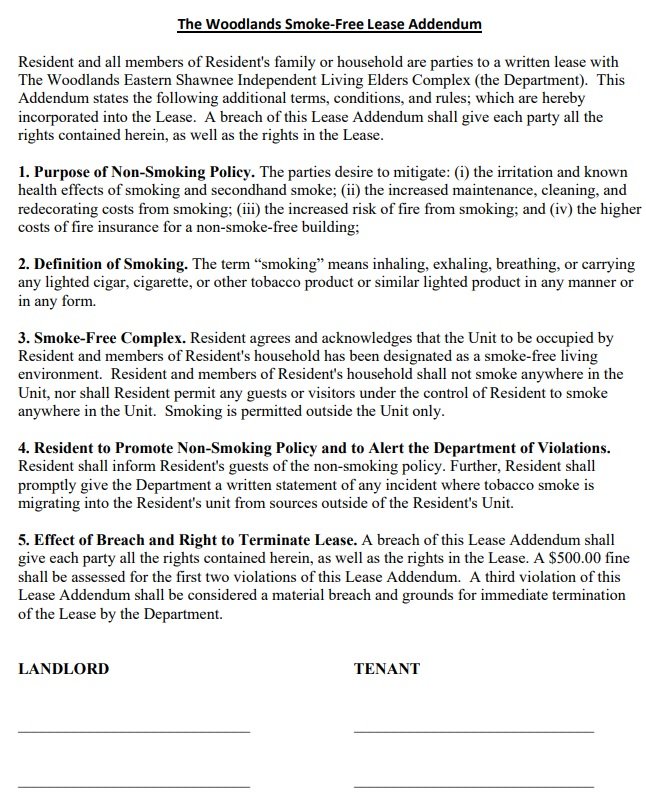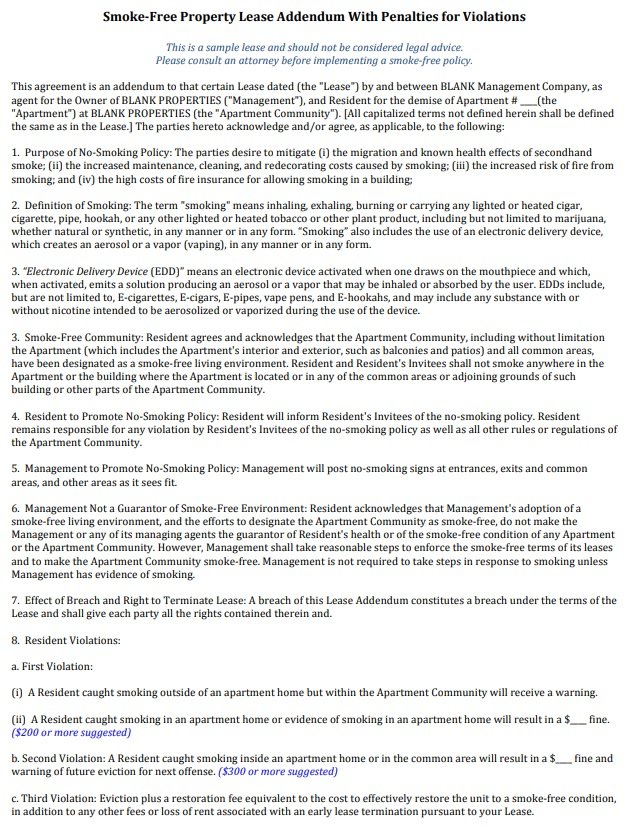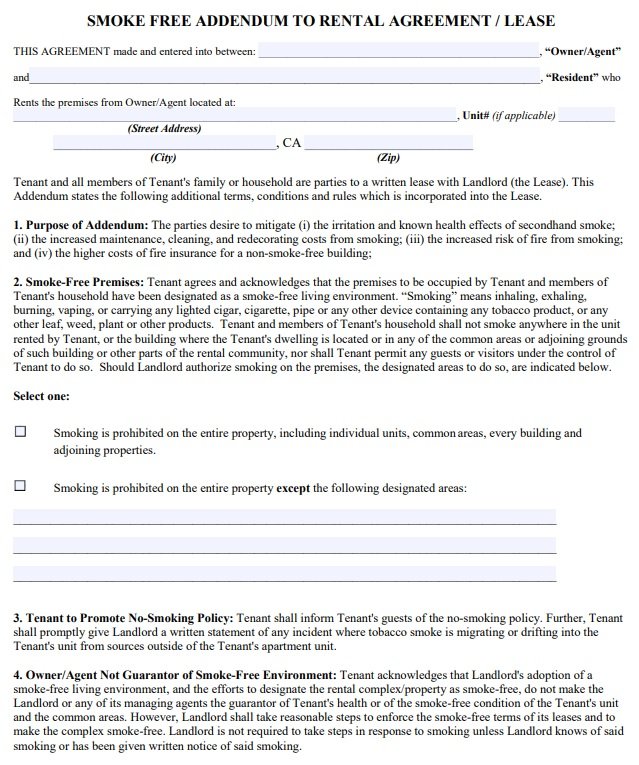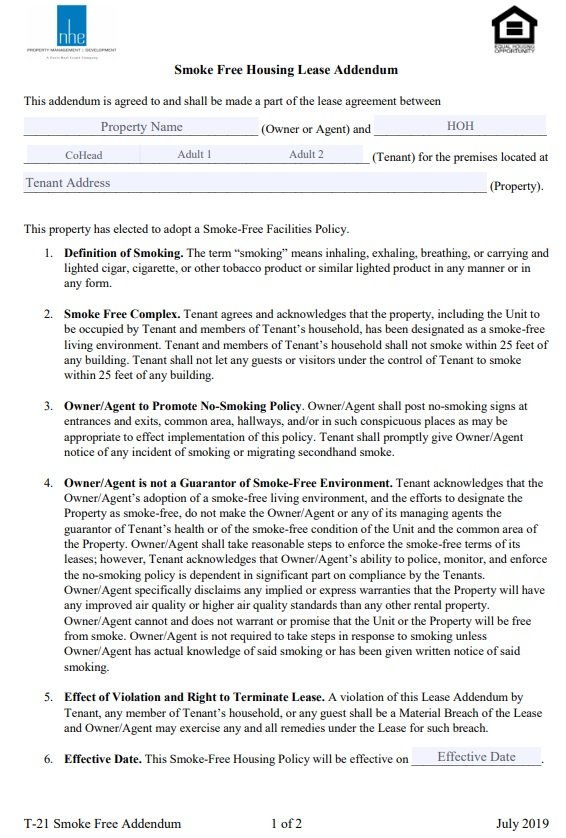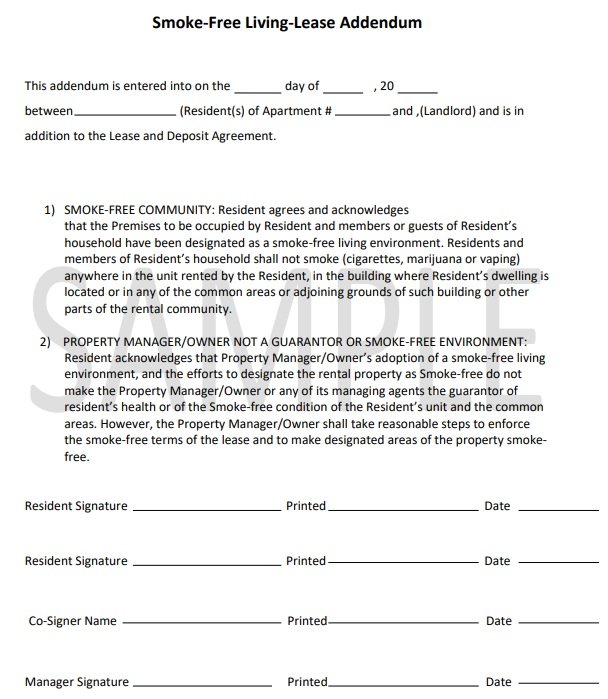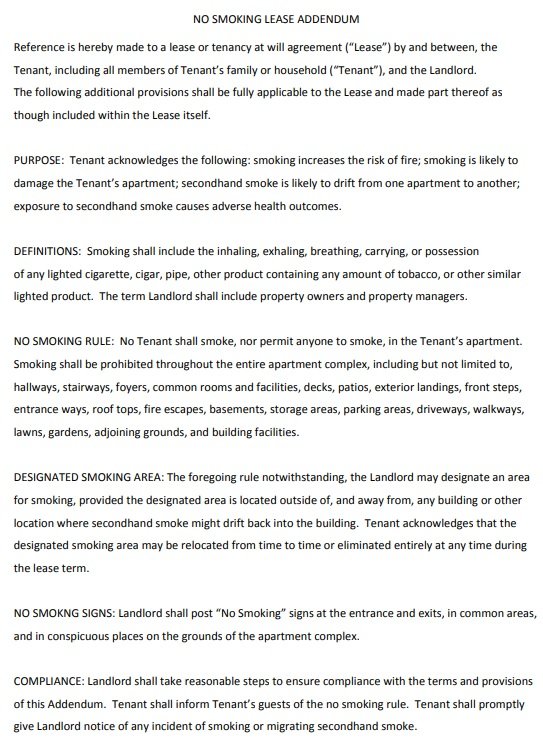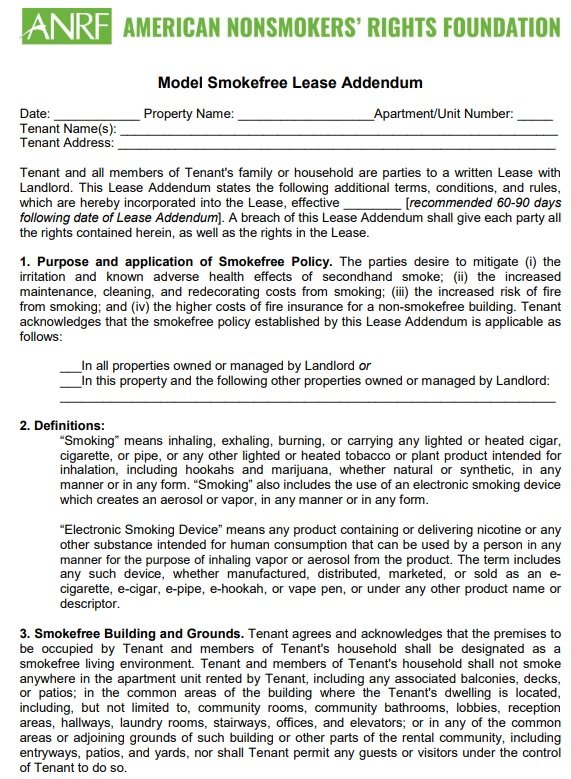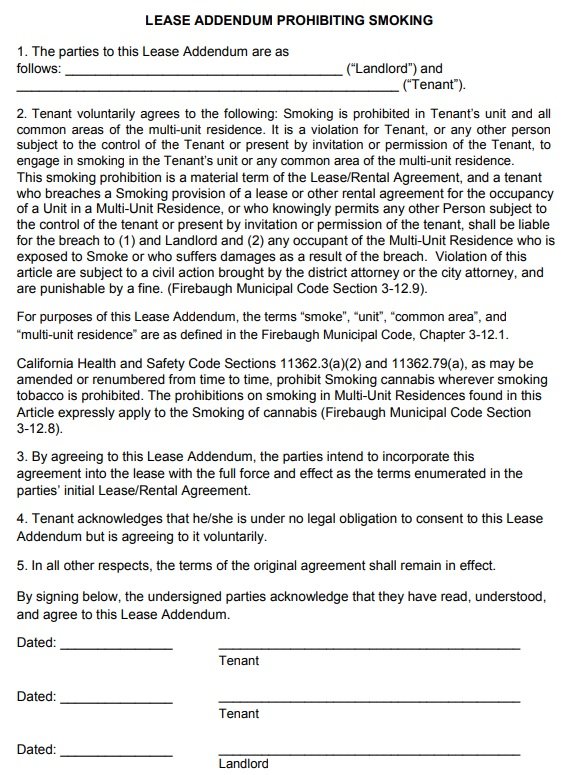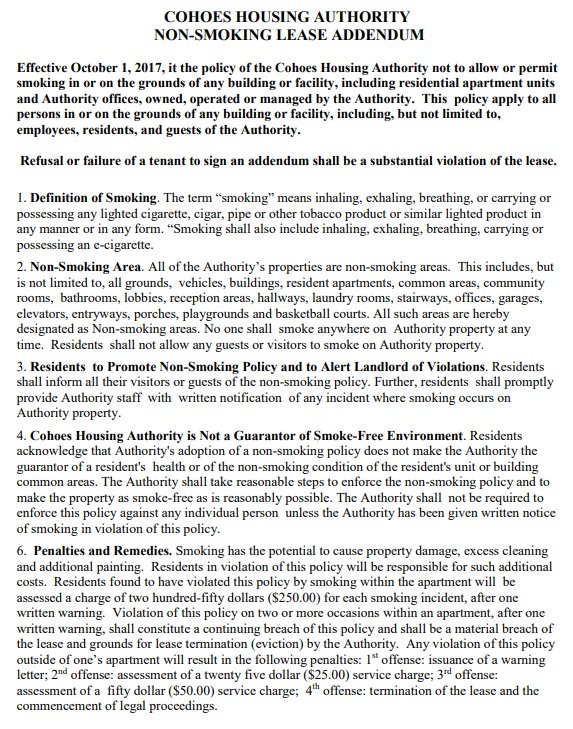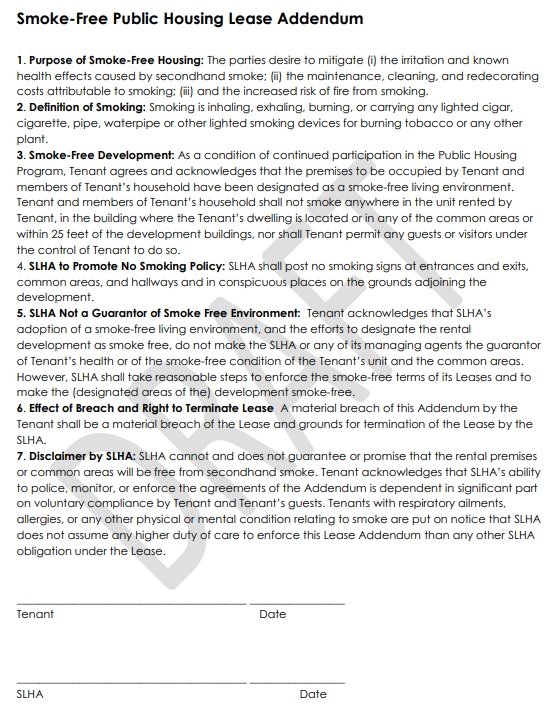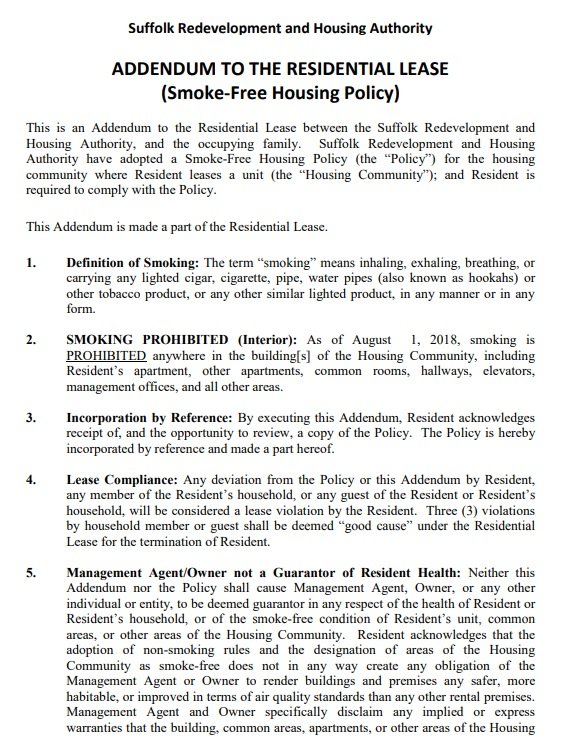A smoking lease addendum is an additional document added to an existing lease agreement that prohibits tenants and their guests from smoking on the premises. This document also the consequences of violating the no-smoking policy.
If the current lease or rental agreement is silent about the smoking policy, the landlords must consider using a smoking lease addendum. Moreover, some other names of this document are;
- Addendum Prohibiting Smoking
- Lease Addendum Prohibiting Smoking
- Marijuana Addendum
- Smoking Addendum
Table of Contents
Reasons for using a smoking policy addendum:
A landlord commonly uses a smoking lease addendum in the following scenarios;
- When the original lease or rental agreement doesn’t contain details about the smoking issue.
- When they are concerned about the tenant’s recent use of smoked substances on the rental property.
Here are a few reasons why landlords should use an addendum to prohibit tobacco and/or cannabis;
- Newly renovated premises
- Well-settled apartment may get damaged
- Tenant has promised verbally not to smoke
- State recently legalized marijuana
- The state has granted permission for the medical or recreational use of marijuana
What consequences you may face if you aren’t using a smoke lease addendum?
Without using a smoke lease addendum, your tenants take advantage of a lease or rental agreement that doesn’t contain details about smoking. An addendum may help to prevent the following;
- Monetary damage
- Legal expenses to evict a tenant
- Costs to find a new tenant
- Property damage
- Replacement cost of furnishings
- Unexpected smoke damage to walls and floors
- Emotional distress
- Managing an upset tenant
- Complaints from neighbors
What are the essential lease addendum clauses?
When writing a lease addendum, clauses are the important thing to consider. Here are some important clauses to include;
Terms clause
The term clause of the lease refers to the duration the tenant is subjected to the terms and conditions mentioned in the lease. Also, this clause specifies the duration of other things that come with the property. Typically, it is the timeframe between the commencement and expiration date of the agreement.
Sublet rules clause
The landlord specifies the rules about subletting in this clause. It may state that the tenant has to inform the landlord when they plan on subletting the rented area. Definitely, the landlord has the right to reject the proposal for their own reasons.
Equipment and facilities maintenance clause
In this clause, the landlord states how the tenant has to take care of the other assets that come into the rented property. These may include kitchenware, washing machines, television sets, and more. Also, the tenants have to pay for these materials if they break them.
Renewal clause
This clause makes it clear whether the lease gets renewed automatically or the tenant has to undergo in order to renew the lease by the end of the term.
Severability clause
In the lease, severability refers to a provision that may be considered null or invalid in court. The severability clause specifies that protection applies to each guaranteed separate policy apart from the parts affected by the coverage limits. Furthermore, this clause protects the terms that the landlord has made at the very start of the transaction.
Disturbance clause
This clause makes sure that the tenants live comfortably and peacefully in the apartment. It discusses the following;
- The specific time when guests are allowed to come
- The number of guests allowed at a time on the premises
- The advised volume of speakers and televisions
If the tenant fails to comply with this clause, they may get penalized.
Access to premises clause
In this clause, the landlord specifies how they are allowed inside the premises for specific reasons. These reasons may include the inspection of the property or the reparation of broken facilities, etc. However, the landlord doesn’t have to provide notice in case of an emergency like a fire, or a bursting pipe in the area. This is because such situations need immediate response.
Buyout clause
Including this clause in the agreement is optional. It grants permission to the tenant to break the lease agreement either within a specified period of time or at any time. This section makes the tenant more comfortable while signing the lease in case they might have a change of heart.
How to write a smoking lease addendum?
Here are the steps to write a smoking lease addendum;
Date of the agreement
First, write the date of the original lease or rental agreement.
Provide landlord and tenant details
Enter the complete names and addresses of the landlord and the tenant as written on the original lease or rental agreement.
State the property address
State the physical address (including any unit or apartment number) of the property being rented.
Smoking areas
Specify whether or not the smoking is allowed in the rented unit. If allowed then specify the areas where smoking on premises is allowed.
Choose indemnification
For any injuries or property damages prohibited smoking causes, specify whether the tenant will indemnify the landlord against liabilities, costs, or claims by third parties.
The lease termination option
State whether the landlord has the right to terminate the lease agreement if tenants breach the terms of the addendum.
Security deposit
Upon breaching the addendum, specify whether the tenant will forfeit the security deposit.
FAQS (Frequently Asked Questions)
Yes. It is legal but the landlord has to make sure that the conditions of the smoking ban are comply with local laws and regulations.
An addendum doesn’t stand on its own, it is just an extension of lease. The original lease agreement and addendum aren’t mutually exclusive even if they are discussing different things.

